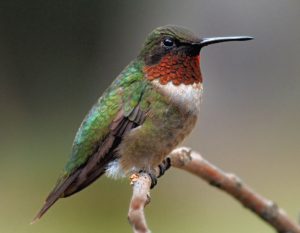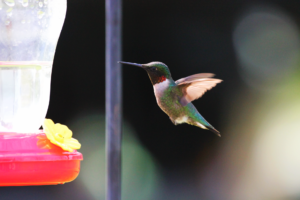by Stephanie Fox
Standing on the beach of High Island, Texas, James “Tyler” Bell saw a handful of tiny dots on the horizon and knew he was about to observe something incredible. Within seconds, they grew closer, hovering just above the water before coming ashore.
Many casual observers would have no idea what was happening. But Bell, a staff scientist at the Smithsonian Environmental Research Center’s Microbial Ecology Lab and an avid bird watcher, knew he was witnessing the “Yucatan Express”—a seasonal event in which millions of ruby-throated hummingbirds spend a single evening flying across the Gulf of Mexico from Central America and Mexico to the breezier north.
“Millions of individual birds…all arrive in their own time, one by one,” Bell said. The birds often fly in clusters, each group completing the Yucatan Express during different evenings throughout the spring.
For 20 hours the ruby-throated hummingbirds travel more than 500 miles across the water without stopping. Their voyage ends in cooler states that are more suitable for their annual summer nesting.
But the miraculous journey takes its toll on the birds that weigh less than a nickel.
A Dangerous Journey
One tribulation the birds face are the northern winds. Think the East Australian Current (the EAC) in Finding Nemo, after the turtle says, “Grab shell, dude,” and everything gets hectic and shouty. Except in the case of a hummingbird that weighs one-eighth of an ounce, there’s no super-chill turtle to anchor themselves to. Fighting being thrown off course can make the already-long flight even longer, and significantly more exhausting. Sadly, this means many birds don’t make it across the Gulf when pushing against the north winds. Those who do survive suffer severe weight loss.
“They’ve literally flown overnight and lost half their body mass,” explained Bell. When the birds finally hit land, the only thing on their minds is food. For them, that means nectar and insects.
“You see them coming in 4 or 5 feet off the water,” Bell said. “They just buzz in and go to the nearest flower they can find.”
Typically, once ruby-throated hummingbirds reach the coast, they’re safe. But this could change in the coming years.
“The insect apocalypse may cause major issues for these birds in the future,” Bell said.
The insect Armageddon he refers to was first thrust into the spotlight in 2017. A group of researchers in Germany observed an estimated three-fourths seasonal decline in flying insect biomass over 27 years in their country’s nature protection areas. Other recent studies have examined insect species around the world, including the Xerces Society for Invertebrate Conservation study, which estimates a 99.4% decline of monarchs migrating from Canada and the northern U.S. to coastal California for the summer. Research continues to reveal population declines in most insect species.
“There are fewer and fewer bugs for [hummingbirds] to eat once they arrive and once they get to their breeding grounds,” said Bell.
A drop in insect populations isn’t the only thing migrating hummingbirds have to worry about.
Weather conditions can significantly alter the number of flowers blooming when the hummingbirds arrive, making finding food difficult, according to the Hummingbird-guide.com, which has an interactive map of hummingbird migrations from 2011 until now.
The lack of nutritional options available could be detrimental to the birds, which often start appearing north around Tax Day. To combat this, Bell recommends northern residents, whether they be in Maryland, Wisconsin, North Carolina or Oregon, get in the habit of hanging hummingbird feeders in their yards.
Hanging Feeders Helps Year-Round
Unlike most bird feeders that can be filled with seeds, hummingbird feeders are specially made for a hummingbird’s diet. They contain a mock nectar solution that can easily be made at home.
Here’s the recipe:
- Fill a 1-cup measuring cup to 200 milliliters with water.
- Heat the cup in the microwave for 90 seconds.
- Add sugar to the heated water until the contents of the measuring cup hit 250 milliliters.
- Stir the cup’s contents until the sugar dissolves completely.
- Let the solution fully cool.
- Pour the sugary drink into the hummingbird feeder.
It’s really that simple.
Other recipes may call for honey or red food dye, but Bell strongly recommends against these additions, as they could cause health issues for the tiny birds.
For those worried that their feeder won’t catch the eye of a hungry hummingbird without red food dye, Bell said the color of most feeders is enough of a draw.
“Almost every hummingbird feeder that you buy now has either a red base or a red reservoir….And that’s all you need to attract them,” Bell said.
Those who hang feeders may never see a bird sipping their home-brewed nectar, which acts as a supplement for the hummingbird’s traditional insect and nectar diet. But that doesn’t mean the hummingbirds aren’t using them.
“If you have a feeder out, you might not even know that [hummingbirds have] come to your feeder,” said Bell. “They could just buzz in, sit there for a minute or two and drink a whole bunch, then continue flying north. It’s kind of an important refueling stop for them.”
With summer just around the corner, the first wave of concern for ruby-throated hummingbirds is upon us, but that doesn’t mean when it gets warmer and flowers start blooming that it’s safe to stop filling the feeders.
“During the summer, it’s nice for the hummingbirds to buzz in and get something quick to eat,” Bell said. This is especially useful for hummingbirds looking after newly hatched young. The feeders also provide a healthy source of food for hummingbirds local to the north.
By August, Bell recommends hanging a second feeder away from the first. Hummingbirds can get territorial over multiple clustered feeders, which can prevent other birds from drinking the nectar.
“If there’s a couple of feeders in one line of sight, you might have one dominant bird that will defend both of them,” explained Bell. If the feeder is on the other side of the house, the territorial bird can’t defend it, freeing up the nectar for other ruby-throated hummingbirds trying to fatten themselves up before the end of summer.
Hanging hummingbird feeders can help ruby-throated hummingbirds maintain a healthy diet. And that means a greater number have a chance of completing their epic 500-mile flight in the spring and making it back south in the fall.




Thank you for letting me know that even though I haven’t seen any, they might still be coming to the hummingbird feeder. Is there anything a novice like me should know about where to place the feeder or whether nearby plants might appeal to them.
How often should the food be changed out?
Thank you so much for showing how simple it is to help these flying jewels!
Sofia: According to our resident birdwatcher, Tyler Bell, red flowering plants are always the best. Placement of the feeder isn’t really that critical. Some people hang their feeders right outside their windows, just a few feet from the glass, while others have them farther out in their yards. Just be sure not to hang two feeders where a single hummingbird can see both, because hummingbirds are very competitive, and one hummingbird might try to defend or lay claim to both feeders.
Here is a link from the Audubon Society with more suggestions for creating a hummingbird-friendly yard: https://www.audubon.org/content/how-create-hummingbird-friendly-yard
Debra: Here’s what our birdwatcher, Tyler Bell, suggests: If the nectar looks at all cloudy, it should be replaced. If the feeder is in the shade most of the day, that will help keep the nectar from going bad as quickly in the summer heat. We only put out a half cup of nectar at a time because we have so little traffic. If it’s busy, they might go through a cup a day. Places in Arizona that host hundreds of hummers go through gallons a day! It’s also important to keep the feeder clean. If there’s any black gunk, it needs to be soap washed and/or mild bleach washed then thoroughly rinsed before being placed outside again.
The squirrels in my area also like to “sip” from the HB feeders. It’s actually pretty funny to see them hanging upside down to reach the nectar.
Will hummingbirds be in the DC region? When?
David: They’re already here! Hummingbirds typically arrive in the Maryland/DC region around mid-April or May and stay through the summer. But don’t be surprised if you don’t see many at your feeder. They often make very quick pit stops and are difficult to spot.
Will they come to Sarasota FL, or are we too warm here?
Jeannetta: There are hummingbirds in Florida too! Check out this map for more details on where and when they’re most commonly seen throughout the state: https://birdsna.org/Species-Account/bna/species/rthhum/introduction